LoL: Why Performance doesn’t equal Viewers in Esports
Why does a consistently high level of performance not always equate to a larger fanbase and viewership? What other factors do teams need to consider in order to become attractive to fans.
Congratulations, the Spring 2022 Season has just finished and through sheer determination and ingenuity you’ve been made the Head Analyst of Team Moneyball, an upcoming League of Legends team, part of the CIL (Canarian Island League — totally fictional).
However, during the off-season an LCS team offered $185M a year to your starting top laner and now you’re against the clock to hunt for an acceptable replacement. Since the Canaries are in the European Union, we’ll stick to LEC players as they won’t need a visa.
Experts in the field tell you that Gold wins games, and so you should pick the player who gets the most. This makes sense to you, but how do we evaluate “Gold”?
Let’s start with a popular one: Gold Difference at X minutes. The definition is simple, at X minutes, what is the difference between how much gold you’ve earnt this game and your direct lane opposition.
There’s a whole debate in itself discussing whether 8, 10, 12 or 14 minutes is best in various circumstances but we’ll ignore that for now and stick with the common 10-minute view.
So, let’s rank the LEC players by their Gold Difference @ 10 from the Spring Split Regular Season (note: for fairness, no play-off games were included)
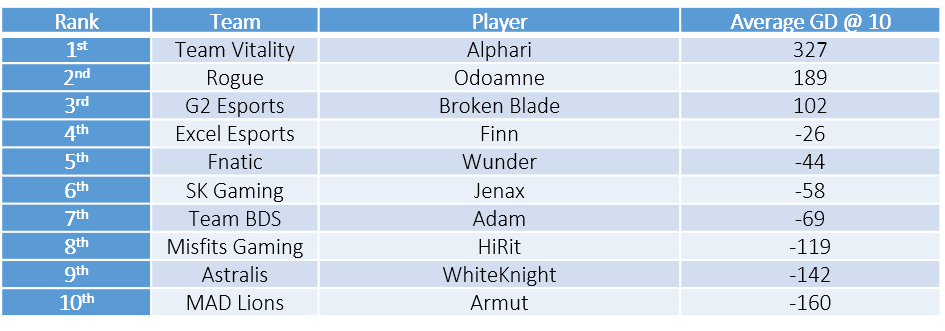
From this, we could conclude that VIT’s Alphari is the best pre-10-minute laner in Europe with a massive 327 average gold advantage by 10 minutes. It’s so high compared to the other players that 4th place onwards are all negative values! This makes him an obvious choice for Team Moneyball.
…Or does it?
Ultimately with these statistics, we’re looking for approximations of how much the player contributes to the result. Who’s actually going to win us more games? With this in mind, how is the gold difference making a… difference?
By limiting the comparison to the direct opposition, we ignore everything else that’s happening in the game. It’s a team game after all, post 10-minutes how much of the result is determined by whether your top laner can duel their top laner in a purely isolated one-on-one?
To make this point clearer, let’s take an extreme example. The average Gold an LEC top laner had at 10 minutes this season was 3,318G. What happens if you had a player who always had 2,000G@10 every game, but they forced their opponent to only have 1,600G (maybe they cheese first blood then dash across the stage and wrestle the opposing player IRL).
By the GD@10 statistic, they’re atop our leaderboard with +400GD. The problem is that even though one player is ahead of the other, they’re both massively behind. When a team fight kicks off, they’ll both be useless — just one will be slightly less useless (unless they’re both still wrestling, of course).
To account for this, let’s instead rank the players by how much Gold they’d accrued by the 10 minute mark.
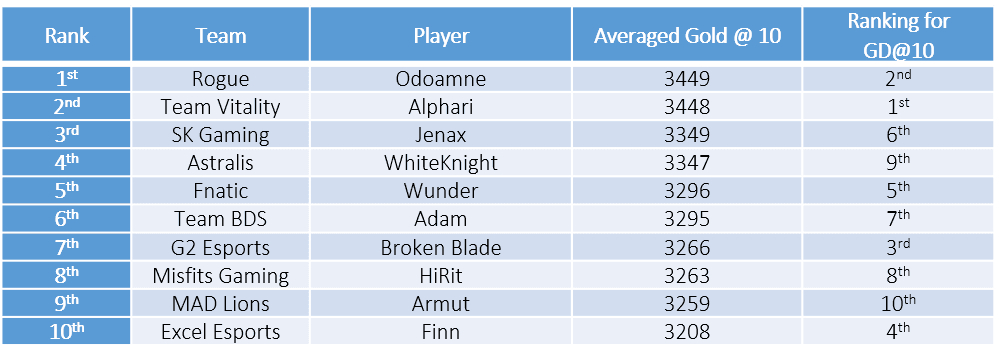
There is a significant shift in the results. Look at XL’s Finn: his GD@10 was a very reasonable -26G, placing him 4th in the league. But for his raw Gold? 10th!
What does this mean? You could argue it’s because when Finn gets ahead, he’s very good at denying resources from his opponent at the cost of his own. A sort of lose, lose.
On the other hand, you could say it’s because when he’s behind he doesn’t make the high risk plays to potentially claw back into the game. He’d rather lose an extra 100G here and there rather than risk dying and giving the opposition a considerable lead.
The direct opposite is someone like AST’s WhiteKnight, who came 9th in Gold Difference but 4th in Gold. He’ll make decisions that ensure he can afford his items regardless of how it impacts the opposing laner.
An example is trading one-for-one during a turret dive. Both players get the Gold from the kill and so they are accelerated. This is a WhiteKnight move.
The flip side to this: overstaying. A player like SK’s Jenax or WhiteKnight might be happy to stay just that little bit longer to secure another wave or plate, even if it risks them dying to their opponent. This gives both teams more Gold, except a plate or wave is worth less than a kill! Their Gold @ 10 increases, their GD@10 decreases.
We’ve looked at the players from two different perspectives of Gold. However, thus far we’ve been using averages. What this ignores is the extremity of each game. A player who goes +1,000G up one game and -1,000G down the next still rocks an average GD@10 of 0 — people may even mistake them for a passive!
We can therefore instead look at the standard deviation. In human terms, how much does their Gold vary from game to game? Are they consistently hitting the same numbers, or do they carry you one game and run it down the next?
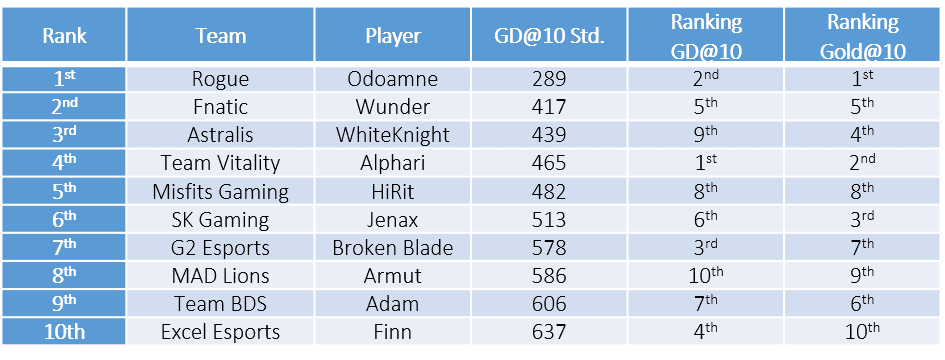
Now, with standard deviations the lower the value the more consistent the player is. A player like RGE’s Odoamne not only has a lot of Gold each game (1st), maintains a lead over his opponents (2nd) but also did it consistently all split long (1st).
BDS’s Adam on the other hand is all over the place. One game he’s 1,146G up on Jayce, the next he’s -1,539G down on Irelia. +612G on Darius then -666G on Gwen, +598G on Sett then -639G on Graves. He’s consistently inconsistent. It’s a playstyle:
“I either win a hero or int enough to become the villain” — Two Face
Which, however, is best?
Let’s say we only had two choices for our top lane spot. One averages +100GD, the other -100GD. Except the former does this by going 1,100G half their games and then -900G the rest. The other player manages to have exactly -100GD every single game.
Choosing between these two is entirely dependent on your needs. If last season you were a 3rd place team with a cracked bot lane, why roll the dice? Pick the consistent player.
If instead, you’re a 10th place team and struggle across the rift, then taking the 50/50 sounds pretty appealing. They’ll be a handful of games you’d be sure to lose with a consistent player, but let Captain YOLO blind pick his signature Yasuo top and hope for the best!
The final factor I’ll discuss is less to do with the Gold itself, but what the player (and their Champion) are capable of doing with it. If you manage to get 10% more resources, do you convert that to 10% more wins?
For this one, we’ll extend the range of data from this season to the entirety of their LEC career.
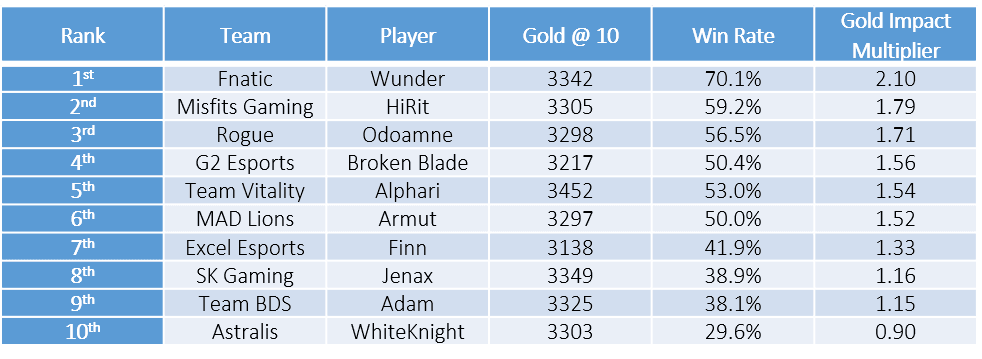
The Gold Impact Multiplier is a little crude, we take the players historic win rate and divide it by their Gold @ 10. We then multiply it by 10,000 to be more readable. This sort of equates to “how much does every extra 1G improve their win rate?”.
For instance, in 1st place is FNC’s Wunder who has won 70% of his non-playoff LEC games and averaged 3,342G by 10 minutes. 8th place Jenax had a higher average Gold@10 of 3,349G, but he has only won 39% of those games.
There of course has to be a huge pinch of salt here to say that the “result” statistic is going to be dependent on the quality of your team. Wunder played a majority of his games during the peak G2 years and therefore benefited from the quality of the team mates he had.
Does being low on this score mean you are a bad player, or just stuck in elo-hell? If you’re atop the list are you someone who can do a lot with a Gold lead, or do you just have a really insane team? It’s hard to say. The only statistically sound solution would be for players to shuffle teams every week and chuck in a few hundred extra games each season, but Riot may not accept my suggestion.
The final consideration on this front is the Champion. Certain kits are just better than others when they have items (which need Gold).
The decision on taking the one-for-one trade should be based on whether it’s better for you to have an extra 500G and them 300G, or better if you gain nothing and they lose 200G. Either way you’re winning, but can you do more with that extra gold than they can?
For instance, if you’re playing Ornn and they’re playing Camille it might not be wise to accept the trade. You’ll do far less with an extra 500G than they will with the 300G. In the mirror match-up, you always take it because you need to get ahead of the curve and who cares if their tank is a bit tankier?
OK, but who you taking?
Really, we’ve not even begun to scratch the surface of how best to analytically evaluate a player, the difficulties of which I discuss in another article.
However, time is up and we have to decide who we’re taking to the next season of the CIL. I aggregated all the rankings below:
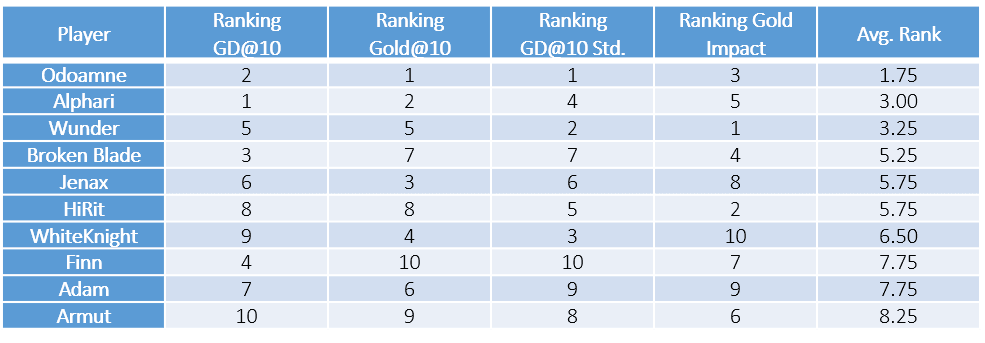
Looks like it’s time for Odoamne to pack his bags and catch the next flight out of Berlin to the sunny city of Las Palmas de Gran Canaria!
Note: the biggest surprise of this exercise was Finn. By GD@10 alone, he’s a top 4 laner. However, due to his low Gold@10 numbers, inconsistence performance and inability to carry with a lead — his actual ranking (using this very simple and unsophisticated system) is much lower.
Here are some other articles that may be of interest.
Why does a consistently high level of performance not always equate to a larger fanbase and viewership? What other factors do teams need to consider in order to become attractive to fans.
How can statistics be used to help player’s scout and draft the best possible esports team in League of Legends (LoL)? What statistics matter? To what extent can AI be used?
How effective can AI be when applied to esports? It benefits from better data, but also a changing game. What is esport’s secret AI weapon?